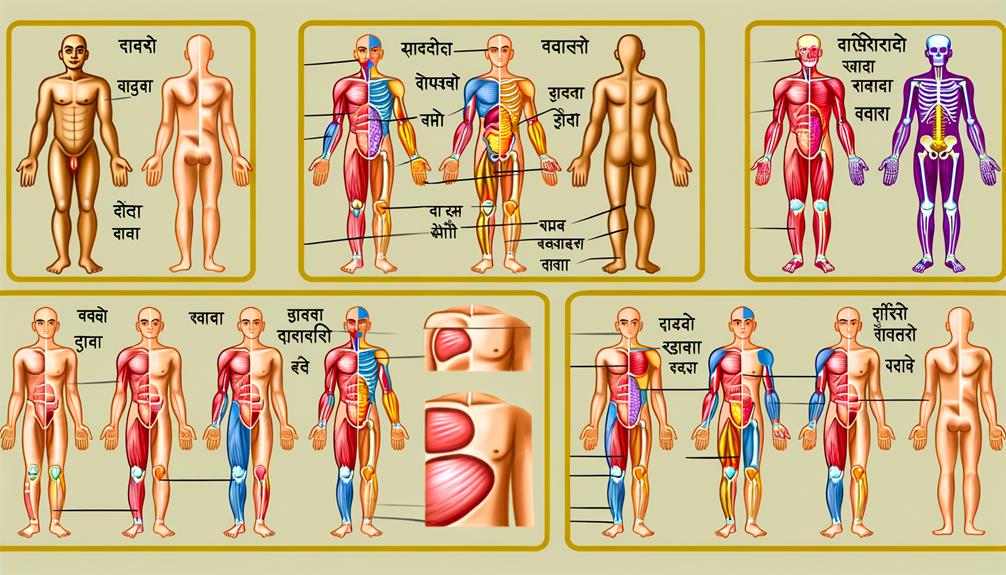Body Parts Name in English With Hindi Meaning
Learning the names of body parts in English with their Hindi meanings is important for communication and anatomical understanding. Key parts include the head (सिर), face (चेहरा), eyes (आंखें), and nose (नाक).
The upper body encompasses the neck (गर्दन), shoulders (कंधे), and chest (छाती). The lower body includes hips (कूल्हे), thighs (जांङें), and feet (पैर).
Internal organs like the heart (दिल), lungs (फेफड़े), and liver (यकृत) are essential for bodily functions. Hands (हाथ) and arms (बांहें) are necessary for daily activities.
Continue to grasp the full spectrum of body parts in both languages.

Key Takeaways
- Head (सिर): The top part of the body housing the brain and sensory organs.
- Eye (आँख): The organ of vision protected by the eyelids.
- Heart (हृदय): The organ that pumps blood throughout the body.
- Lung (फेफड़ा): The organ responsible for gas exchange during breathing.
- Hand (हाथ): The appendage used for grasping and manipulating objects.
Head and Face
The head and face encompass several crucial components of the human body, each with distinct names in English and corresponding meanings in Hindi.
The head, or 'सर' (Sar), supports crucial sensory organs.
The face, known as 'चेहरा' (Chehra), includes the forehead ('माथा' or Matha), eyes ('आंखें' or Aankhen), ears ('कान' or Kaan), nose ('नाक' or Naak), and mouth ('मुंह' or Munh).
The eyes, crucial for vision, are protected by eyelids ('पलकें' or Palkein).
The nose facilitates breathing and smell, while the mouth aids in speech and digestion.
The ears are essential for hearing and balance.
Each part contributes significantly to daily functions, illustrating the complexity and importance of the head and face.
Upper Body
Moving from the head and face, the upper body comprises several essential parts such as the neck ('गर्दन' or Gardan), shoulders ('कंधे' or Kandhe), chest ('छाती' or Chhati), and back ('पीठ' or Peeth). Understanding these parts is necessary for various aspects of health and fitness.
Here are three key elements of the upper body:
- Neck (गर्दन or Gardan): Supports the head and facilitates its movement.
- Shoulders (कंधे or Kandhe): Provide a range of motion for the arms and are pivotal in lifting and carrying.
- Chest (छाती or Chhati): Houses essential organs including the heart and lungs, playing a critical role in respiration and circulation.
Lower Body
The lower body includes essential parts such as the hips ('कूल्हे' or Kule), thighs ('जांघें' or Janghe), knees ('घुटने' or Ghoothne), and feet ('पैर' or Pair), all of which play important roles in mobility and support.
The hips provide a stable base and support the weight of the upper body. Thighs contain powerful muscles that facilitate walking, running, and jumping. Knees act as pivotal joints, allowing for leg flexion and extension. Feet, comprising various bones, muscles, and tendons, support body weight and enable balance and locomotion.
Understanding these parts and their functions can greatly enhance one's knowledge of human anatomy and its intricacies in daily movements.
Internal Organs
Internal organs, integral to bodily functions, include the heart ('दिल' or Dil), lungs ('फेफड़े' or Phephade), liver ('जिगर' or Jigar), and kidneys ('गुर्दे' or Gurde). These organs play pivotal roles in maintaining health and homeostasis.
- Heart (दिल or Dil): Pumps blood throughout the body, supplying oxygen and nutrients.
- Lungs (फेफड़े or Phephade): Facilitate gas exchange, bringing oxygen into the body and expelling carbon dioxide.
- Liver (जिगर or Jigar): Processes nutrients, detoxifies harmful substances, and produces bile for digestion.
Understanding these organs helps us appreciate their essential contributions to our overall well-being. Proper care, such as a balanced diet and regular exercise, supports their function.
Hands and Arms
Hands and arms, frequently employed in daily activities, are essential for a wide range of functions from basic tasks to complex movements. These parts of the body allow us to perform everything from lifting and carrying to intricate tasks like writing and typing. Understanding their names in both English and Hindi can enhance our comprehension and communication skills.
| English | Hindi |
|---|---|
| Hand | हाथ (Haath) |
| Arm | बांह (Baanh) |
| Wrist | कलाई (Kalai) |
| Elbow | कोहनी (Kohni) |
Mastering these terms can deepen our appreciation for the body's capabilities and improve our ability to describe physical sensations or medical conditions accurately. Whether in professional settings or everyday interactions, this knowledge is invaluable.
Feet and Legs
Feet and legs, fundamental for locomotion and balance, play a pivotal role in supporting the body's weight and enabling movement. Understanding their structure and function is essential for maintaining overall health.
Here are some essential terms related to feet and legs, along with their meanings in Hindi:
- Foot (पैर): The terminal part of the leg, essential for standing and walking.
- Ankle (टखना): The joint connecting the foot with the leg, enabling foot movement.
- Thigh (जांघ): The upper part of the leg, extending from the hip to the knee, important for strength and mobility.
Each part has a unique function, contributing to the intricate system that allows us to move and stay balanced.
Sensory Organs
Sensory organs, essential to perceiving and interacting with our environment, are specialized structures that detect stimuli and send information to the brain. These organs allow us to experience the world through vision, hearing, smell, taste, and touch. In both English and Hindi, understanding the names of these organs enhances our appreciation of human anatomy and its functions.
| English | Hindi | Function |
|---|---|---|
| Eyes | आँखें (Aankhen) | Detect light and enable vision |
| Ears | कान (Kaan) | Detect sound waves and enable hearing |
| Nose | नाक (Naak) | Detect odors and enable the sense of smell |
These sensory organs play vital roles in daily life, making their study necessary for thorough anatomical knowledge.
Conclusion
To wrap up, understanding the names of body parts in both English and Hindi can enhance communication and cultural appreciation. From the head and face to the feet and legs, each section of the body has its unique terminology.
Internal organs play crucial roles, while sensory organs connect individuals to their environment. How can one fully appreciate the complexity of human anatomy without recognizing the linguistic diversity that describes it? This knowledge fosters both educational growth and intercultural competence.






